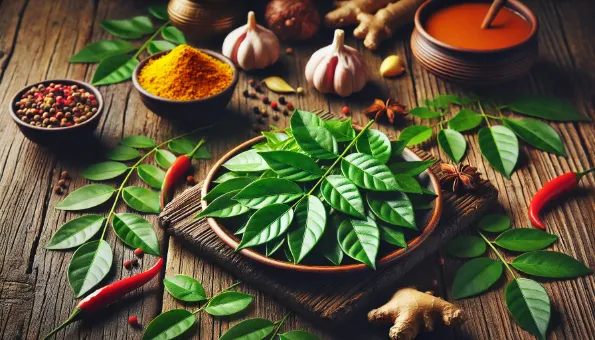Curry Leaves: Aroma, Nutrition, and Uses
Fragrant South Asian leaves used for tempering. Rich in vitamin C, carotenoids and antioxidants with a gentle citrusy, nutty note.

Introduction
Curry leaves (Murraya koenigii) are aromatic leaves widely used in Indian and Sri Lankan cooking—especially in **tadka/tempering**. They are not the same as curry powder. Fresh leaves sizzle in hot oil to release bright, citrusy-herbal flavors.
Nutritional Snapshot (typical 5 g fresh leaves)
| Nutrient | Level |
|---|---|
| Energy | low |
| Fiber | present |
| Vitamin C | high |
| Vitamin A (carotenoids) | high |
| Calcium & Iron | source |
| Phytonutrients | carbazole alkaloids, antioxidants |
Benefits
- **Antioxidants** may help combat oxidative stress
- **Vitamin C & carotenoids** support immunity and vision
- Gentle **digestive support**; great in light, low-calorie dishes
- Adds flavor without added sugar or gluten (naturally **vegan**)
Considerations
- Strong aroma: use sparingly, remove whole leaves before serving if desired
- Fresh leaves are perishable; dry or freeze for later
- Not a substitute for curry powder (different ingredient entirely)
Culinary Uses
Bloom in oil with mustard seeds, cumin, garlic or chilies for dals, sambar, coconut chutneys, lemon rice and vegetable stir-fries. Also infuse into ghee or oil for drizzling.
Tips
- **Bloom** 10–20 seconds in hot oil to release aroma
- Freeze whole sprigs; use from frozen
- Pair with **mustard seeds, coconut, lime, garlic, ginger**
Fun Fact
In many South Indian homes, a small curry leaf plant is kept by the kitchen door for daily picking.
- 1. Curry Leaves
svježi listovi karija (Murraya koenigii); mirisno začinsko lišće za temperiranje jela, bogato vitaminom C i antioksidansima

